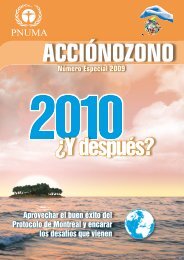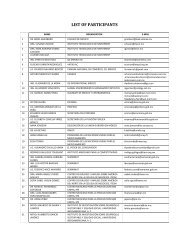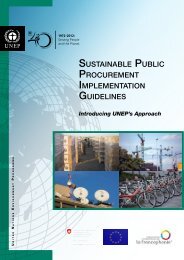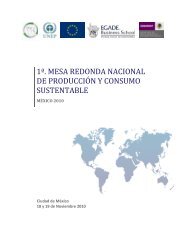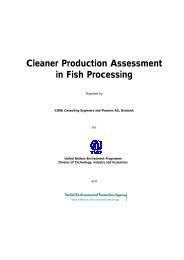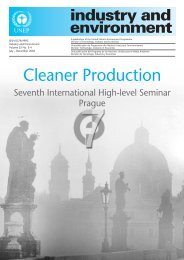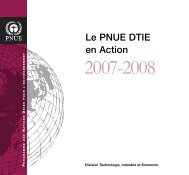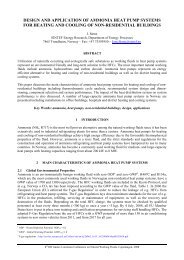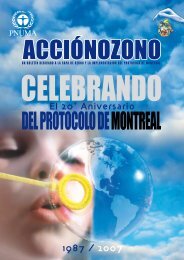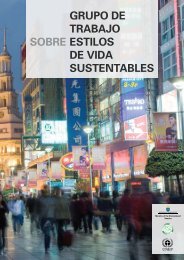Checklist for Action - Financing Cleaner Production
Checklist for Action - Financing Cleaner Production
Checklist for Action - Financing Cleaner Production
Create successful ePaper yourself
Turn your PDF publications into a flip-book with our unique Google optimized e-Paper software.
Profiting from <strong>Cleaner</strong> <strong>Production</strong><br />
<strong>Checklist</strong>s <strong>for</strong> <strong>Action</strong><br />
UNITED NATIONS ENVIRONMENT PROGRAMME<br />
DIVISION OF TECHNOLOGY, INDUSTRY AND ECONOMICS<br />
39-43 quai André Citroën<br />
75739 Paris Cedex 15 - France<br />
Tel: +33 1 44 37 14 50<br />
Fax: +33 1 44 37 14 74<br />
E-mail: unep.tie@unep.fr<br />
Acknowledgements<br />
These checklists are adapted from UNEP documents, UNEP DTIE <strong>Cleaner</strong> <strong>Production</strong> Investment training programmes and tools<br />
used by various experts. Special thanks go to Colin Sutherland, Deborah Savage, Atle Mil<strong>for</strong>d, Chris Bray, and Jürgis Stanikis and<br />
to the Mekong Project Development Facility (operated by the International Finance Corporation) <strong>for</strong> their valuable comments.<br />
© Copyright 2002 UNEP<br />
All rights reserved. No part of this publication may be reproduced, stored in a retrieval system or transmitted in any <strong>for</strong>m or by<br />
any means, electronic, electrostatic, magnetic tape, mechanical, photocopying, recording or otherwise, without permission in<br />
writing from the copyright holders.<br />
First edition 2002<br />
The designations employed and the presentation of the material in this publication do not imply the expression of any opinion<br />
whatsoever on the part of the United Nations Environment Programme concerning the legal status of any country, territory, city or<br />
area or of its frontiers or boundaries. Moreover, the views expressed do not necessarily represent the decision or the stated policy<br />
of the United Nations Environment Programme, nor does citing of trade names or commercial processes constitute endorsement.<br />
UNITED NATIONS PUBLICATION<br />
ISBN: 92-807-2202-6<br />
United Nations Environment Programme – Division of Technology, Industry and Economics 1
2 United Nations Environment Programme – Division of Technology, Industry and Economics
Profiting from <strong>Cleaner</strong> <strong>Production</strong><br />
<strong>Checklist</strong>s <strong>for</strong> <strong>Action</strong><br />
Contents<br />
Background . . . . . . . . . . . . . . . . . . . . . . . . . . . . . . . . . . . . . . . . . . . . . . . . . . . . . . . . . . . . . . .4<br />
Profiting from <strong>Cleaner</strong> <strong>Production</strong>: <strong>Checklist</strong>s <strong>for</strong> <strong>Action</strong> . . . . . . . . . . . . . . . . . . . . . .4<br />
Adding to or adapting the checklists . . . . . . . . . . . . . . . . . . . . . . . . . . . . . . . . . . . . . . . .4<br />
A Barriers to <strong>Cleaner</strong> <strong>Production</strong> checklist . . . . . . . . . . . . . . . . . . . . . . . . . . . . . . . .5-6<br />
B <strong>Cleaner</strong> <strong>Production</strong> implementation checklists . . . . . . . . . . . . . . . . . . . . . . . . .7-11<br />
B1 Scope <strong>for</strong> <strong>Cleaner</strong> <strong>Production</strong> . . . . . . . . . . . . . . . . . . . . . . . . . . . . . . . . . . . . . . . . . . . . .7-9<br />
B2 <strong>Cleaner</strong> <strong>Production</strong> enterprise strategy options . . . . . . . . . . . . . . . . . . . . . . . . . . . . .10<br />
B3 Government intervention to promote <strong>Cleaner</strong> <strong>Production</strong> investment . . . . . . . .11<br />
C <strong>Cleaner</strong> <strong>Production</strong> investment proposal checklists . . . . . . . . . . . . . . . . . . .12-13<br />
C1 <strong>Cleaner</strong> <strong>Production</strong> investment data sources . . . . . . . . . . . . . . . . . . . . . . . . . . . . . . . .12<br />
C2 <strong>Cleaner</strong> <strong>Production</strong> investment decisions: Detailed cost checklist . . . . . . . . . . . . .13<br />
D <strong>Cleaner</strong> <strong>Production</strong> funding checklists . . . . . . . . . . . . . . . . . . . . . . . . . . . . . . .14-21<br />
D1 Funding options . . . . . . . . . . . . . . . . . . . . . . . . . . . . . . . . . . . . . . . . . . . . . . . . . . . . . . . . . .14<br />
D2 Funding application <strong>for</strong>mat . . . . . . . . . . . . . . . . . . . . . . . . . . . . . . . . . . . . . . . . . . . . .15-16<br />
D3 <strong>Checklist</strong> <strong>for</strong> bankers on <strong>Cleaner</strong> <strong>Production</strong> issues . . . . . . . . . . . . . . . . . . . . . . . . . .17<br />
D4 In<strong>for</strong>mation needs of banks and credit institutions when evaluating<br />
applications <strong>for</strong> finance . . . . . . . . . . . . . . . . . . . . . . . . . . . . . . . . . . . . . . . . . . . . . . . . . . .18<br />
D5 <strong>Checklist</strong> <strong>for</strong> credit officers on <strong>Cleaner</strong> <strong>Production</strong> issues . . . . . . . . . . . . . . . . .19-20<br />
D6 Risks in lending to smaller businesses . . . . . . . . . . . . . . . . . . . . . . . . . . . . . . . . . . . . . .21<br />
E<br />
Complementary tools <strong>for</strong> further improvement of environmental<br />
per<strong>for</strong>mance . . . . . . . . . . . . . . . . . . . . . . . . . . . . . . . . . . . . . . . . . . . . . . . . . . . . . . . . .22<br />
For further in<strong>for</strong>mation . . . . . . . . . . . . . . . . . . . . . . . . . . . . . . . . . . . . . . . . . . . . . . . . . . .23<br />
United Nations Environment Programme – Division of Technology, Industry and Economics 3
Profiting from <strong>Cleaner</strong> <strong>Production</strong><br />
<strong>Checklist</strong>s <strong>for</strong> <strong>Action</strong><br />
Background<br />
<strong>Cleaner</strong> <strong>Production</strong> is the continuous application of an integrated preventive environmental strategy to processes,<br />
products and services to increase overall efficiency and reduce risks to humans and the environment. <strong>Cleaner</strong><br />
<strong>Production</strong> can be applied to the processes used in any industry, to products themselves and to various services provided<br />
in society.<br />
Prevention is better business than allowing inefficiency to result in losses. The <strong>Cleaner</strong> <strong>Production</strong> community knows<br />
and affirms this, but most sources of investment financing remain unaware or unconvinced. While <strong>Cleaner</strong><br />
<strong>Production</strong> has made tremendous headway in the engineering community in the last ten years, financing is often<br />
seen as one of the main constraints on its wider practice.<br />
However, there has been some progress in this area. Research initiatives have multiplied on issues related to sustainable<br />
finance, donor agencies have launched demonstration projects, and special financial mechanisms <strong>for</strong><br />
<strong>Cleaner</strong> <strong>Production</strong> investment have emerged in a number of countries in recent years.<br />
In addition, financial markets are becoming more sensitive on environment and sustainability. Costs of capital depend<br />
mainly on the results of assessments of expected risk and return, and issues related to sustainability influence both<br />
risk and return. There is also recent evidence that institutional investors increasingly support sustainability.<br />
Profiting from <strong>Cleaner</strong> <strong>Production</strong>: <strong>Checklist</strong>s <strong>for</strong> <strong>Action</strong><br />
A checklist is a list of actions to take or items to verify. It helps the user to obtain more in<strong>for</strong>mation or to make evaluations<br />
or judgements.<br />
The checklists here are designed <strong>for</strong>:<br />
Implementers - Enterprises considering or using <strong>Cleaner</strong> <strong>Production</strong> approaches;<br />
Investors - Banks and other financial institutions that may consider funding <strong>Cleaner</strong> <strong>Production</strong> projects;<br />
Facilitators - Promoters or supporters of <strong>Cleaner</strong> <strong>Production</strong>: Government, non-governmental organizations, consultants<br />
and the media.<br />
Adding to or adapting the checklists<br />
All the checklists are available on the UNEP DTIE website at: www.uneptie.org/pc/cp, so users can personalize them<br />
by, <strong>for</strong> instance:<br />
• Including the name of an organization<br />
• Adding sections or points<br />
• Including findings or recommendations<br />
The need <strong>for</strong> these checklists emerged during the implementation of Norwegian-funded UNEP/DTIE project<br />
“Strategies and mechanisms <strong>for</strong> promoting <strong>Cleaner</strong> <strong>Production</strong> investments in developing countries”. They are<br />
intended as support instruments to guide users in government, private and public industry and the financial<br />
community in their decision making.<br />
4 United Nations Environment Programme – Division of Technology, Industry and Economics
Profiting from <strong>Cleaner</strong> <strong>Production</strong><br />
<strong>Checklist</strong>s <strong>for</strong> <strong>Action</strong><br />
A Barriers to <strong>Cleaner</strong> <strong>Production</strong> checklist<br />
Objective: The purpose of this checklist is to help identify constraints at national or industry level on implementing<br />
<strong>Cleaner</strong> <strong>Production</strong>. In many cases, individual enterprises cannot change such constraints on their own. The final list<br />
of “Yes”answers provides a profile of the barriers that any individual enterprise, government body or finance provider<br />
may face. The columns under “Response” are to be filled in by the user of the checklist.<br />
ISSUE<br />
1. Lower cost-effectiveness of <strong>Cleaner</strong> <strong>Production</strong> investments,<br />
compared with other investment opportunities, given<br />
present resource prices<br />
2. Perception that such investments carry a higher financial<br />
risk because of <strong>Cleaner</strong> <strong>Production</strong> ‘s innovative nature<br />
YES/NO<br />
RESPONSE<br />
ACTION OR RECOMMENDATION<br />
3. The dominance of the pollution control industry, which<br />
makes it difficult <strong>for</strong> <strong>Cleaner</strong> <strong>Production</strong> to get established<br />
4. High cost of external capital <strong>for</strong> <strong>Cleaner</strong> <strong>Production</strong><br />
investments in industry<br />
Enterprise Economic/Financial<br />
5. Higher initial costs of some <strong>Cleaner</strong> <strong>Production</strong> technologies<br />
make them harder to sell to smaller enterprises than the<br />
“traditional” technologies<br />
6. Lack of funding mechanisms and lending programmes<br />
appropriate <strong>for</strong> <strong>Cleaner</strong> <strong>Production</strong> investments<br />
7. Lack of interest on the part of financial institutions in<br />
financing projects requiring only small amounts of finance<br />
8. Difficulty in evaluating the economic soundness of <strong>Cleaner</strong><br />
<strong>Production</strong> projects leading to reluctance to fund them<br />
even when their financial benefits are proven<br />
9. Failure to consider the value of <strong>Cleaner</strong> <strong>Production</strong> in<br />
evaluation procedures <strong>for</strong> lending, equity participation, etc.<br />
10. Competing demands <strong>for</strong> scarce resources make it difficult<br />
to consider longer-term <strong>Cleaner</strong> <strong>Production</strong> investments<br />
even when the benefits are known<br />
Environment<br />
1. Lack of leadership on environmental issues<br />
2. Lack of real concern <strong>for</strong> environmental problems at plant<br />
and management level<br />
3. Traditional “end-of-pipe” pollution control philosophy<br />
on the part of many managers<br />
4. Lack of incentives <strong>for</strong> managers to work on implementing<br />
<strong>Cleaner</strong> <strong>Production</strong> activities<br />
Continued on page 6<br />
United Nations Environment Programme – Division of Technology, Industry and Economics 5
Profiting from <strong>Cleaner</strong> <strong>Production</strong><br />
<strong>Checklist</strong>s <strong>for</strong> <strong>Action</strong><br />
Continued from page 5<br />
ISSUE<br />
5. General resistance to change: Pollution control techniques<br />
and technologies are typically simpler to understand and<br />
thus easier to use on existing production processes<br />
<strong>Cleaner</strong> <strong>Production</strong> projects<br />
1. Too few demonstration projects in relevant sub-sectors or<br />
locations to illustrate the benefits of <strong>Cleaner</strong> <strong>Production</strong><br />
YES/NO<br />
RESPONSE<br />
ACTION OR RECOMMENDATION<br />
National/Government Enterprise<br />
2. General immaturity of the organization structure and of<br />
the management and in<strong>for</strong>mation systems<br />
3. Limited experience with employee involvement and<br />
project work<br />
4. Lack of a sound operational basis with well-established<br />
production practices, maintenance systems, etc.<br />
5. Perception that <strong>Cleaner</strong> <strong>Production</strong> is complex<br />
(e.g. that it requires comprehensive assessment to identify<br />
appropriate opportunities)<br />
6. Limited access to equipment to support <strong>Cleaner</strong> <strong>Production</strong><br />
1. Immaturity of the environmental policy framework<br />
2. En<strong>for</strong>cement activities that tend to be weak, thus putting<br />
no real pressure on enterprises<br />
3. Authorities that tend to favour pollution control approaches<br />
as the standard <strong>for</strong> regulatory compliance<br />
4. Too narrow interpretation or misunderstanding of the<br />
<strong>Cleaner</strong> <strong>Production</strong> concept<br />
5. Insufficient focus on <strong>Cleaner</strong> <strong>Production</strong> in trade and<br />
industry development strategies<br />
6. Limited accessibility of reliable technical in<strong>for</strong>mation<br />
tailored to the company’s needs and assimilative capacity<br />
7. Immaturity of the internal cost calculation and cost<br />
allocation practices<br />
8. Immaturity of the internal capital budgeting and capital<br />
allocation procedures<br />
9. Macroeconomic and social policies (e.g. energy pricing<br />
regimes and subsidies <strong>for</strong> uneconomic industries) that<br />
discourage <strong>Cleaner</strong> <strong>Production</strong><br />
10. Insufficient research and development initiatives in new<br />
<strong>Cleaner</strong> <strong>Production</strong> technologies<br />
6 United Nations Environment Programme – Division of Technology, Industry and Economics
Profiting from <strong>Cleaner</strong> <strong>Production</strong><br />
<strong>Checklist</strong>s <strong>for</strong> <strong>Action</strong><br />
B <strong>Cleaner</strong> <strong>Production</strong> implementation checklists<br />
B1<br />
Scope <strong>for</strong> <strong>Cleaner</strong> <strong>Production</strong><br />
Objective: The need <strong>for</strong> <strong>Cleaner</strong> <strong>Production</strong> can be signalled in many ways, not all of them immediately apparent.<br />
The objective of this checklist is to highlight situations that demonstrate scope <strong>for</strong> <strong>Cleaner</strong> <strong>Production</strong>.<br />
SITUATION YES/NO FOLLOW-UP<br />
In the flow of operations<br />
1. Disorganized flow – great ef<strong>for</strong>t in some locations,<br />
little in others<br />
2. Considerable rehandling of materials in a given condition<br />
3. Slow progress of materials through the production processes<br />
4. Disorganized work methods and clerical work flow<br />
5. Cramped or inconveniently located service departments<br />
6. Excessive scrap and reworking of production<br />
7. Failure to meet delivery deadlines<br />
Enterprise<br />
8. Excessive number of back orders or rush orders<br />
9. Excessive overtime<br />
10. Sub-standard output quality<br />
In material handling and storage<br />
1. Considerable manual handling of heavy material<br />
2. Inadequately numbered, identified and/or protected supplies<br />
3. Crowded/congested stores and aisles<br />
4. Handling of single units rather then full loads<br />
5. Frequent damage or loss of materials in handling<br />
Continued on page 8<br />
United Nations Environment Programme – Division of Technology, Industry and Economics 7
Profiting from <strong>Cleaner</strong> <strong>Production</strong><br />
<strong>Checklist</strong>s <strong>for</strong> <strong>Action</strong><br />
Continued from page 7<br />
SITUATION YES/NO FOLLOW-UP<br />
6. Need to transport materials long distances on site<br />
7. Excessive or unbalanced inventories or stocks of raw materials<br />
In accounting and reporting<br />
1. Lack of budgetary control system and/or costing system<br />
2. Difficulty valuing work in progress and/or finished goods<br />
Government Enterprise<br />
3. Inadequate/unreliable cost accounting in<strong>for</strong>mation<br />
4. Lack of operations in<strong>for</strong>mation (e.g. bills of material,<br />
operations lists, machine loadings)<br />
5. Poor filing systems and difficulty finding documents<br />
6. Lateness of financial reports to management/owners<br />
7. Non-existent or ad hoc capital investment programme,<br />
1. Environmental regulations that do not always take<br />
into account <strong>Cleaner</strong> <strong>Production</strong><br />
2. Lack of availability of up-to-date in<strong>for</strong>mation of <strong>Cleaner</strong><br />
<strong>Production</strong> practices and technologies addressing specific<br />
local, regional or national needs<br />
3. Not enough awareness campaigns on the benefits of <strong>Cleaner</strong><br />
<strong>Production</strong> <strong>for</strong> financial institutions<br />
4. Lack of promotion of training and skills development courses<br />
on <strong>Cleaner</strong> <strong>Production</strong> <strong>for</strong> employees at various industry levels<br />
5. Insufficiently developed <strong>Cleaner</strong> <strong>Production</strong> advisory services<br />
6. Non existent or not sufficient special incentives <strong>for</strong> <strong>Cleaner</strong><br />
<strong>Production</strong> adoption (e.g. tax breaks) and/or penalties <strong>for</strong> no<br />
compliance (negative externalities)<br />
7. Yet to be developed indicators to measure progress in the<br />
adoption of <strong>Cleaner</strong> <strong>Production</strong><br />
8. Not sufficient development of <strong>Cleaner</strong> <strong>Production</strong><br />
demonstration projects in various industrial sub-sectors,<br />
particularly in small and medium-sized enterprises<br />
Continued on page 9<br />
8 United Nations Environment Programme – Division of Technology, Industry and Economics
Profiting from <strong>Cleaner</strong> <strong>Production</strong><br />
<strong>Checklist</strong>s <strong>for</strong> <strong>Action</strong><br />
Continued from page 8<br />
SITUATION YES/NO FOLLOW-UP<br />
Government<br />
9. Insufficient promotion of <strong>Cleaner</strong> <strong>Production</strong> as a main topic<br />
in financial and business management courses<br />
10. <strong>Cleaner</strong> <strong>Production</strong> consultancy as a new profession is not<br />
encouraged enough<br />
United Nations Environment Programme – Division of Technology, Industry and Economics 9
Profiting from <strong>Cleaner</strong> <strong>Production</strong><br />
<strong>Checklist</strong>s <strong>for</strong> <strong>Action</strong><br />
B <strong>Cleaner</strong> <strong>Production</strong> implementation checklists<br />
B2<br />
<strong>Cleaner</strong> <strong>Production</strong> enterprise strategy options<br />
Objective: This checklist gives the generally accepted options <strong>for</strong> implementing <strong>Cleaner</strong> <strong>Production</strong> measures, with<br />
those that are easiest to implement or lowest in cost topping the list.<br />
OPTION<br />
1. Good Housekeeping<br />
Take action to prevent leaks and spills, develop preventive<br />
maintenance, improve equipment inspections and en<strong>for</strong>ce<br />
existing working instructions through proper supervision<br />
and training.<br />
WORTH<br />
CONSIDERING<br />
Yes, always<br />
ACTION<br />
2. Input Material Substitution<br />
Replace usual inputs with less toxic and/or renewable<br />
materials, and usual lubricants, coolants, cleansing agents,<br />
etc., with those that have a longer service lifetime.<br />
3. Improved Process Control<br />
Modify working procedures, such as machine instructions<br />
and process record keeping, to run processes more efficiently<br />
and reduce waste and emission generation rates.<br />
4. Equipment Modification<br />
Modify existing equipment and support utilities to improve<br />
processes and reduce waste and emission generation rates.<br />
5. Technology Change<br />
Replace existing technologies, processing sequences<br />
and/or synthesis pathways so as to minimize waste<br />
and emission generation.<br />
6. On-site Recovery/Reuse/Recycle<br />
Reuse waste materials in the same production process<br />
or elsewhere in the enterprise or group.<br />
7. <strong>Production</strong> of Useful By-products<br />
Trans<strong>for</strong>m waste into a useful by-product to be sold as input<br />
<strong>for</strong> companies in other sectors.<br />
8. Product Re<strong>for</strong>mulation<br />
Change the characteristics of the product to minimize<br />
the environmental impacts of its production,<br />
use and/or disposal.<br />
10 United Nations Environment Programme – Division of Technology, Industry and Economics
Profiting from <strong>Cleaner</strong> <strong>Production</strong><br />
<strong>Checklist</strong>s <strong>for</strong> <strong>Action</strong><br />
B Strategy and capacity-building checklists<br />
B3<br />
Government intervention to promote <strong>Cleaner</strong> <strong>Production</strong> investment<br />
Objective: The purpose of this checklist is to help identify practical ways that central and local government can<br />
encourage investment in <strong>Cleaner</strong> <strong>Production</strong>.<br />
Main activities<br />
1. Introduce appropriate legislation, including taxation<br />
and financial instruments.<br />
2. Ensure effective en<strong>for</strong>cement.<br />
3. Provide economic incentives.<br />
4. Encourage voluntary agreements.<br />
5. Build local skills and support capacity.<br />
6. Spread understanding of <strong>Cleaner</strong> <strong>Production</strong> concepts.<br />
7. Provide demonstration projects.<br />
8. Initiate in<strong>for</strong>mation and promotion programmes.<br />
9. Help overcome financial constraints.<br />
Selected additional activities<br />
1. Develop comprehensive <strong>Cleaner</strong> <strong>Production</strong> programmes <strong>for</strong><br />
the country/region/locality.<br />
2. Formulate and improve national/regional/local policies to promote<br />
<strong>Cleaner</strong> <strong>Production</strong>.<br />
3. Promote <strong>Cleaner</strong> <strong>Production</strong> at political level and develop policies<br />
to promote it.<br />
4. Develop <strong>Cleaner</strong> <strong>Production</strong> declarations <strong>for</strong> signature at ministerial level.<br />
5. Publicise <strong>Cleaner</strong> <strong>Production</strong> concepts among decision makers.<br />
6. Develop environmental criteria <strong>for</strong> economic cooperation<br />
and technology introduction.<br />
7. Require waste minimization assessment and regular reports<br />
to government authorities.<br />
8. Provide grants <strong>for</strong> pilot testing of <strong>Cleaner</strong> <strong>Production</strong> technology.<br />
9. Require better consumer in<strong>for</strong>mation.<br />
10. Tackle trade conflicts associated with <strong>Cleaner</strong> <strong>Production</strong>.<br />
11. Develop awareness and application of <strong>Cleaner</strong> <strong>Production</strong> in small<br />
and medium- sized enterprises.<br />
12. Make in<strong>for</strong>mation on <strong>Cleaner</strong> <strong>Production</strong> readily available (e.g. ensure that<br />
newsletters and bulletins on <strong>Cleaner</strong> <strong>Production</strong> are widely distributed).<br />
13. Support and finance research and development in <strong>Cleaner</strong> <strong>Production</strong><br />
technology.<br />
14. Support <strong>Cleaner</strong> <strong>Production</strong> through export promotion programmes.<br />
ALREADY<br />
IN PLACE<br />
CONSIDER<br />
OR INTRODUCE<br />
United Nations Environment Programme – Division of Technology, Industry and Economics 11
Profiting from <strong>Cleaner</strong> <strong>Production</strong><br />
<strong>Checklist</strong>s <strong>for</strong> <strong>Action</strong><br />
C<br />
<strong>Cleaner</strong> <strong>Production</strong> investment proposal checklists<br />
C1<br />
<strong>Cleaner</strong> <strong>Production</strong> investment data sources<br />
Objective: The aim of this checklist is to identify sources of in<strong>for</strong>mation, which will help in:<br />
• Identifying <strong>Cleaner</strong> <strong>Production</strong> options<br />
• Providing in<strong>for</strong>mation <strong>for</strong> investment proposals<br />
DEPARTMENT<br />
12 United Nations Environment Programme – Division of Technology, Industry and Economics<br />
INFORMATION SOURCES<br />
1. General Management • Organizational charts<br />
• In<strong>for</strong>mation on available investment funds<br />
2. Accounting & Finance • Cost accounting reports <strong>for</strong> departments, activities, products, etc.<br />
• Overhead account in<strong>for</strong>mation<br />
• Department and project budgets<br />
3. Purchasing • Raw material invoices and delivery records<br />
• Material data sheets<br />
• Energy bills<br />
• Water bills<br />
• Waste transport/recycling/disposal invoices<br />
• Vendor contact in<strong>for</strong>mation<br />
4. Material Control & Inventory • Raw material inventory records<br />
• Final product inventory records<br />
• Material handling records<br />
5. Operations • Process maps/descriptions<br />
• Equipment operating manuals<br />
• Equipment energy use ratings<br />
• Work orders and job sheets<br />
• Batch recipes and other product specifications<br />
• <strong>Production</strong> schedules<br />
• Material ordering tickets<br />
• <strong>Production</strong> logs<br />
6. Quality Control • Product specifications<br />
• QC and product reject data<br />
7. Sales & Marketing • Invoices to customers<br />
8. Shipping • Shipping records<br />
9. Maintenance & Engineering • Facility blueprints and schematics<br />
• Equipment lists, specifications and data sheets<br />
• Maintenance procedures and records<br />
10. Environment, Health & Safety • Emission/waste technical analyses<br />
• Emission/waste volumes<br />
• Sewer discharge records<br />
• Recycling records<br />
• Waste shipment records<br />
• Regulatory compliance reports<br />
• Data on environmental penalties and fines<br />
• Data on environmental clean-up costs<br />
• Permitting cost estimates<br />
• Waste management labour costs<br />
• Pollution control equipment in<strong>for</strong>mation<br />
• Future regulatory compliance costs<br />
11. Legal • Environmental legal costs<br />
12. Research & Development • Future environmental and cost trends<br />
Note: This checklist is meant to be illustrative. The availability and location of different types of data can vary widely from enterprise to enterprise.
Profiting from <strong>Cleaner</strong> <strong>Production</strong><br />
<strong>Checklist</strong>s <strong>for</strong> <strong>Action</strong><br />
C<br />
<strong>Cleaner</strong> <strong>Production</strong> investment proposal checklists<br />
C2<br />
<strong>Cleaner</strong> <strong>Production</strong> investment decisions: Detailed cost checklist<br />
Objective: This checklist breaks down costs that can affect decisions on investing in <strong>Cleaner</strong> <strong>Production</strong>.<br />
COST<br />
COST<br />
Planning/engineering (including materials, labour)<br />
• Planning<br />
• Design/engineering<br />
• Accounting<br />
• Procurement<br />
Permitting (including materials, labour, permit fees)<br />
• Siting permits<br />
• Construction permits<br />
• Environmental permits<br />
• Contractor/consultant fees<br />
Site preparation (including materials, labour)<br />
• Land purchase<br />
• Equipment rental<br />
• Demolition and clearing<br />
• Old equipment/rubbish disposal<br />
• Grading, landscaping<br />
• Building construction<br />
Equipment purchase (including taxes, delivery,<br />
insurance, installation)<br />
• Process equipment<br />
• Monitoring equipment<br />
• Protective/safety equipment<br />
• Materials handling equipment<br />
• Storage equipment<br />
• Laboratory equipment<br />
Working capital<br />
• Raw materials inventory<br />
• Product inventory<br />
• Accounts receivable/payable<br />
• Taxes payable<br />
• Cash<br />
Utilities/connections (including materials, labour)<br />
• Electricity<br />
• Fuel<br />
• Heating<br />
• Cooling/refrigeration<br />
• Water<br />
• Steam<br />
• Sewerage<br />
• Plant air<br />
• Inert gas<br />
Training (including materials, labour)<br />
• Operations training<br />
• Safety/environmental training<br />
Costs <strong>for</strong> the first operating week<br />
(cannot always be ascertained )<br />
Shut-down/Start-up costs<br />
• Test runs<br />
Contingency fund<br />
Salvage value<br />
• Transport equipment<br />
• Waste handling equipment<br />
• Rework/recycling equipment<br />
• Waste treatment equipment<br />
• Initial spare parts<br />
United Nations Environment Programme – Division of Technology, Industry and Economics 13
Profiting from <strong>Cleaner</strong> <strong>Production</strong><br />
<strong>Checklist</strong>s <strong>for</strong> <strong>Action</strong><br />
D <strong>Cleaner</strong> <strong>Production</strong> funding checklists<br />
D1<br />
Funding options<br />
Objective: The aim of this checklist is to help identify sources of funding. An example of a funded project is also provided.<br />
TYPE OF FUNDING SOURCE<br />
Close to home<br />
• Internal finance sources – self financing<br />
• Loans from owners or other stakeholders<br />
• Credit from other trade associates such as suppliers or customers<br />
Equipment-related<br />
• Credit from equipment supplier<br />
• Lease finance<br />
Bank<br />
• Credit terms from banks<br />
• Loans from own bank<br />
• Loans from other banks<br />
Government and other<br />
• Grants and/or loans from government bodies<br />
• Preferential funding sources – environmental credit lines<br />
• Venture capital funds<br />
• Other<br />
OPTION?<br />
(YES/NO)<br />
USED<br />
EXAMPLE OF FUNDING<br />
JOB SPECIFICATION CONTRACTOR COSTS SOURCE<br />
Designing works <strong>for</strong> steam boiler installation X Company 2 375 USD Self<br />
Equipment: X Company Soft loan<br />
Steam boiler VAPOR TTK-60 35 225 USD from NEFCO<br />
Fittings (direct from the boiler)<br />
5 312 USD<br />
Oil burner OILON RP-140M<br />
13 650 USD<br />
Boiler feeding pump CR4-120<br />
1 300 USD<br />
Oil pumps Allweiler SPF-20-38 (2 units)<br />
2 800 USD<br />
Extended smoke channel to chimney X Company 1 500 USD Self<br />
Assembling of boiler, electrical-automation part,<br />
pipelines and isolation works; start-up – adjustment works<br />
X Company<br />
11 450 USD<br />
Soft loan<br />
from NEFCO<br />
Sub-total<br />
73 612 USD<br />
Contingency costs (10%)<br />
7 361 USD<br />
TOTAL<br />
80 973 USD<br />
14 United Nations Environment Programme – Division of Technology, Industry and Economics
Profiting from <strong>Cleaner</strong> <strong>Production</strong><br />
<strong>Checklist</strong>s <strong>for</strong> <strong>Action</strong><br />
D <strong>Cleaner</strong> <strong>Production</strong> funding checklists<br />
D2<br />
Funding application <strong>for</strong>mat<br />
Objective: This checklist gives the suggested contents of a typical <strong>Cleaner</strong> <strong>Production</strong> funding application. It is not<br />
meant to serve as a “standard <strong>for</strong>mat” <strong>for</strong> a <strong>Cleaner</strong> <strong>Production</strong> loan application.<br />
CONTENT<br />
CHECK<br />
Cover sheet A one-page summary of the project (see example on the next page)<br />
Background Company name, type and level of production, annual turnover, etc.<br />
(with audited balance sheet and profit-loss statement as appendices)<br />
Project description<br />
a) Current facilities<br />
b) Ownership of the enterprise<br />
c) Proposed project (rationale, justification and explanation, project objectives quantified:<br />
cost savings, environmental improvements, market, etc. )<br />
Project costs<br />
a) Expected total investment costs, including contingency fund (approximately 10%)<br />
b) Total investment costs broken down by main contractors, including local works<br />
c) Pre- and post-operating costs (changes in operating and maintenance costs due to project<br />
implementation), including taxes (separately), interest, etc.<br />
d) Financial costs summary (external and self-financing) and payback period<br />
Project implementation<br />
a) Summary of plans <strong>for</strong> project implementation, monitoring and management arrangements<br />
b) Names and responsibilities of main parties<br />
c) <strong>Financing</strong>/lending disbursement plan<br />
d) Expected start-up and termination dates (state concrete action or documentation required<br />
according to the contract, when applicable)<br />
e) Schedule of activities (main delivery dates)<br />
Continued on page 16<br />
United Nations Environment Programme – Division of Technology, Industry and Economics 15
Profiting from <strong>Cleaner</strong> <strong>Production</strong><br />
<strong>Checklist</strong>s <strong>for</strong> <strong>Action</strong><br />
Continued from page 15<br />
CONTENT<br />
Project impact on environment, health and safety<br />
CHECK<br />
a) Mitigation of environmental impacts arising from project implementation<br />
b) Compliance/permits from regulatory authorities, and mode of environmental review<br />
c) Statement on environmental, health and safety screening conducted during project preparation<br />
and finalized during project appraisal and on environmental, health and safety issues associated<br />
with the project<br />
d) Proof of compliance with international standards<br />
COVER SHEET<br />
A one-page summary of the project<br />
Applicant . . . . . . . . . . . . . . . . . . . . . . . . . . . . . . . . . .(name of enterprise)<br />
Project title . . . . . . . . . . . . . . . . . . . . . . . . . . . . . . . . .Modernization of boiler house<br />
Sector covered . . . . . . . . . . . . . . . . . . . . . . . . . . . . .Energy/district heating<br />
Project impact: . . . . . . . . . . . . . . . . . . . . . . . . . . . . .100 GWh/y saved<br />
. . . . . . . . . . . . . . . . . . . . . . . . . . . . . . . . . . . . . . . . . . . .Annual reduction of:<br />
130 000 t CO 2 emission<br />
10 t dust emission<br />
150 t SO 2 emission<br />
Project duration . . . . . . . . . . . . . . . . . . . . . . . . . . . .4 months<br />
Total cost . . . . . . . . . . . . . . . . . . . . . . . . . . . . . . . . . . .Capital ——— USD<br />
. . . . . . . . . . . . . . . . . . . . . . . . . . . . . . . . . . . . . . . . . . . .Operating ——— USD<br />
Proposed bank financing . . . . . . . . . . . . . . . . . . .Capital ——— USD<br />
Other financing (name resources) . . . . . . . . . . .Capital ——— USD<br />
Cost-effectiveness (internal rate of return) . . .10%<br />
Payback period . . . . . . . . . . . . . . . . . . . . . . . . . . . . .years/months<br />
16 United Nations Environment Programme – Division of Technology, Industry and Economics
Profiting from <strong>Cleaner</strong> <strong>Production</strong><br />
<strong>Checklist</strong>s <strong>for</strong> <strong>Action</strong><br />
D <strong>Cleaner</strong> <strong>Production</strong> funding checklists<br />
D3<br />
<strong>Checklist</strong> <strong>for</strong> bankers on <strong>Cleaner</strong> <strong>Production</strong> issues<br />
Objective: This checklist can be used, in conjunction with normal funding application documentation, when reviewing<br />
<strong>Cleaner</strong> <strong>Production</strong> funding applications. For major funding requests, a “yes” should be backed up by documents<br />
or systems examples. For negative answers, the additional credit and other risks should be specified. If <strong>Cleaner</strong><br />
<strong>Production</strong> funding is being given special preference, negative answers may need to be reconsidered.<br />
CRITERIA MEASUREMENT QUESTION YES NO<br />
1. Have <strong>for</strong>mal investment criteria been defined when developing the investment proposal?<br />
2. Has the investment decision-making process considered:<br />
• Short- and long-term <strong>Cleaner</strong> <strong>Production</strong> impacts of the expenditure?<br />
• Business as well as <strong>Cleaner</strong> <strong>Production</strong> justifications?<br />
• <strong>Cleaner</strong> <strong>Production</strong> benefit realization and result measurement?<br />
• Relevant environmental laws and regulations plus measures taken to assure compliance?<br />
3. Do those making the investment decision have:<br />
• Knowledge of <strong>Cleaner</strong> <strong>Production</strong> solutions on the market?<br />
• Experience in purchasing this type of equipment or service?<br />
• Undertaken basic feasibility studies?<br />
• Confirmed supplier reliability and responsibilities?<br />
4. Will a <strong>for</strong>mal legally binding document exist <strong>for</strong> any purchase of <strong>Cleaner</strong> <strong>Production</strong><br />
technology or services?<br />
5. Is there clear management accountability <strong>for</strong> tracking and controlling <strong>Cleaner</strong> <strong>Production</strong><br />
expenditure?<br />
6. Are experienced and skilled staff available to implement or use the <strong>Cleaner</strong> <strong>Production</strong><br />
methodology or equipment?<br />
7. Have implementation milestones and reviews been incorporated into the <strong>Cleaner</strong> <strong>Production</strong><br />
funding application?<br />
United Nations Environment Programme – Division of Technology, Industry and Economics 17
Profiting from <strong>Cleaner</strong> <strong>Production</strong><br />
<strong>Checklist</strong>s <strong>for</strong> <strong>Action</strong><br />
D <strong>Cleaner</strong> <strong>Production</strong> funding checklists<br />
D4<br />
In<strong>for</strong>mation needs of banks and credit institutions when evaluating applications<br />
<strong>for</strong> finance<br />
Objective: In addition to specific in<strong>for</strong>mation on a <strong>Cleaner</strong> <strong>Production</strong> investment proposal, banks require more general<br />
in<strong>for</strong>mation on the borrowers and their ability to repay. The aim of this checklist is to identify the main questions or<br />
issues that banks will likely want to address so they can evaluate whether the borrowing enterprise is well-managed.<br />
Written in<strong>for</strong>mation will be needed. Make sure you have the facts and documents available.<br />
AVAILABLE<br />
1. Business or enterprise<br />
• Date established<br />
• Location, short history, structure<br />
• Names and short biographies of owners<br />
2. Key management<br />
• Age, experience and qualifications of senior management<br />
• Organization chart showing responsibilities<br />
3. Marketplace<br />
• Position locally, main competitors, description of products/services<br />
• Level of technology (include brochures)<br />
4. Financial position and per<strong>for</strong>mance<br />
• Current assets and liabilities<br />
• Latest financial accounts, up-to-date figures on debtors, creditors and work in progress<br />
• Inventories, other loans, bank balance<br />
5. Business plan<br />
• Objectives to be met with the funds to be borrowed<br />
• Expenditure budget and cash budget<br />
6. Funds required<br />
• How much and when, showing appropriateness <strong>for</strong> business size<br />
• Margin <strong>for</strong> error and change in circumstances<br />
• Break-even <strong>for</strong> profitability and cash<br />
7. Structure of required finance<br />
• Short, medium or long term needs<br />
• Export finance requirements<br />
8. Available collateral<br />
• Assets already pledged (collaterals) <strong>for</strong> other loans<br />
• Assets available as collateral <strong>for</strong> this loan<br />
9. Repayment issues<br />
• Starting date and overall plan<br />
• Repayment plan<br />
18 United Nations Environment Programme – Division of Technology, Industry and Economics
Profiting from <strong>Cleaner</strong> <strong>Production</strong><br />
<strong>Checklist</strong>s <strong>for</strong> <strong>Action</strong><br />
D <strong>Cleaner</strong> <strong>Production</strong> funding checklists<br />
D5<br />
<strong>Checklist</strong> <strong>for</strong> credit officers on <strong>Cleaner</strong> <strong>Production</strong> issues<br />
Objective: The aim of this checklist is to guide those evaluating applications <strong>for</strong> <strong>Cleaner</strong> <strong>Production</strong> funding in verifying<br />
statements made about <strong>Cleaner</strong> <strong>Production</strong>.<br />
Question 1:<br />
YES/NO<br />
FOLLOW-UP<br />
Has the enterprise published an environmental policy statement,<br />
and is this investment part of the strategy described therein?<br />
Objective evidence: Published environmental policy statement<br />
dating from be<strong>for</strong>e the financial assistance application was made.<br />
Reason <strong>for</strong> question: If the enterprise has environmental protection<br />
and <strong>Cleaner</strong> Protection as part of its mission statement, it is aware<br />
of the issues. The investment application is thus likely to be genuine<br />
rather than a cover <strong>for</strong> a more general funding arrangement.<br />
Question 2:<br />
In previous applications <strong>for</strong> financial support <strong>for</strong> non-<strong>Cleaner</strong><br />
<strong>Production</strong> projects, did the enterprise make any reference to<br />
environmental impact or environmental good practice?<br />
Objective evidence: Previous financial assistance applications.<br />
Reason <strong>for</strong> question: If environmental protection and <strong>Cleaner</strong><br />
Protection have been part of the enterprise’s mission <strong>for</strong> a while,<br />
you would expect this to be reflected in earlier applications or other<br />
bank/customer relations records.<br />
Question 3:<br />
Does the application clearly identify the <strong>Cleaner</strong> <strong>Production</strong><br />
elements within the application?<br />
Objective evidence: <strong>Cleaner</strong> <strong>Production</strong> and environmental<br />
protection items identified and costed within the application.<br />
Reason <strong>for</strong> question: Most applications will give a mix of economic<br />
and environmental justification <strong>for</strong> the investment. However, there<br />
should be clear evidence of the specific justification <strong>for</strong> <strong>Cleaner</strong><br />
<strong>Production</strong> investments, where the criteria, options considered,<br />
opportunity costs, time horizons and discount rates will be different.<br />
Question 4:<br />
Where relevant, does the application recognize and provide <strong>for</strong><br />
indirect <strong>Cleaner</strong> <strong>Production</strong> environmental costs, such as<br />
landscaping, waste disposal, decommissioning and abandonment?<br />
Objective evidence: Identified items costed within the application.<br />
Reason <strong>for</strong> question: For a project to be judged as environmentally<br />
friendly, all impacts of the investment should be considered. Some<br />
will be up-front costs such as landscaping, others will occur during<br />
operations and still others, such as decommissioning, at the end of<br />
the project life. Such costs should be addressed in the application.<br />
Continued on page 20<br />
United Nations Environment Programme – Division of Technology, Industry and Economics 19
Profiting from <strong>Cleaner</strong> <strong>Production</strong><br />
<strong>Checklist</strong>s <strong>for</strong> <strong>Action</strong><br />
Continued from page 19<br />
Question 5:<br />
Does the applicant have accounting and environmental<br />
measurement systems in place to monitor and report on<br />
the expected financial benefits and savings used in justifying<br />
the application?<br />
Objective evidence: Description of systems and example of sample<br />
reports.<br />
Reason <strong>for</strong> question: Established accounting processes are evidence<br />
that the applicant can measure how well, and by how much,<br />
the introduction of <strong>Cleaner</strong> <strong>Production</strong> benefits it. They also add<br />
credibility to the financial figures included in the application.<br />
Question 6:<br />
YES/NO<br />
FOLLOW-UP<br />
Does the application refer to:<br />
• Requirements of national environmental laws?<br />
• Local laws and regulations?<br />
• State tax allowances and benefits?<br />
Objective evidence: Contents of application.<br />
Reason <strong>for</strong> question: Failure to refer to laws and regulations<br />
by name and number may imply that the applicant is unfamiliar<br />
with the legislation, which would put the investment at risk.<br />
20 United Nations Environment Programme – Division of Technology, Industry and Economics
Profiting from <strong>Cleaner</strong> <strong>Production</strong><br />
<strong>Checklist</strong>s <strong>for</strong> <strong>Action</strong><br />
D <strong>Cleaner</strong> <strong>Production</strong> funding checklists<br />
D6<br />
Risks in lending to smaller businesses<br />
Objective: Extending credit to small and medium-sized enterprises can entail additional exposure and risks, compared<br />
with those involved in lending to larger enterprises. This checklist presents some of the main risk areas and<br />
gives an example of each.<br />
TYPE OF RISK EXPOSURE CONTROL<br />
1. Overall business<br />
Does the enterprise have an established history and<br />
experience in its current or proposed business related to<br />
the investment proposal?<br />
2. Nature of activity<br />
Do the enterprise and its activity carry an inherently high<br />
environmental risk?<br />
3. Legal and regulatory<br />
Is the enterprise registered and does it operate within relevant<br />
laws and regulations?<br />
Does it know about any emerging legislation?<br />
4. In<strong>for</strong>mation<br />
Can the enterprise provide complete and credible in<strong>for</strong>mation<br />
on its operations and financial position?<br />
5. Systems operations and transactions<br />
Does the enterprise have business operational systems<br />
to control?<br />
6. Skills and capacities<br />
Does the enterprise have people with the skills and knowledge<br />
to lead and manage the enterprise properly?<br />
Does it have staff knowledgeable of <strong>Cleaner</strong> <strong>Production</strong>?<br />
7. Collateral<br />
Is the enterprise the real registered owner of the property<br />
it wishes to offer as collateral?<br />
8. Financial capacity<br />
Is the small enterprise co-financing in any way the <strong>Cleaner</strong><br />
<strong>Production</strong> investment it is seeking external funds <strong>for</strong>?<br />
Or is it applying <strong>for</strong> 100%?<br />
United Nations Environment Programme – Division of Technology, Industry and Economics 21
Profiting from <strong>Cleaner</strong> <strong>Production</strong><br />
<strong>Checklist</strong>s <strong>for</strong> <strong>Action</strong><br />
E<br />
Complementary tools <strong>for</strong> further improvement of environmental per<strong>for</strong>mance<br />
Objective: <strong>Cleaner</strong> <strong>Production</strong> has close links with the field of environmental management, as well as with other<br />
approaches and techniques that can be applied to improve the environmental per<strong>for</strong>mance of any enterprise. The<br />
objective of this checklist is to identify these and consider their relevance to a given enterprise.<br />
MANAGEMENT TOOL<br />
USED<br />
(YES/NO)<br />
MORE INFORMATION<br />
REQUIRED<br />
1. Environmental auditing<br />
Systematic, documented, periodic and objective evaluation of how well<br />
a project, organization, management and equipment are per<strong>for</strong>ming,<br />
with the aim of helping safeguard the environment.<br />
2. Environmental technology assessment<br />
Can be used by technology suppliers, developers, importers<br />
and exporters, plus local communities and non-governmental<br />
organizations. Typically includes:<br />
• Assessing the environmental impact of a given technology<br />
• Selecting among technology options<br />
• Improving design of a technology<br />
• Identifying ways to mitigate negative effects of a technology<br />
3. Environmental Management Accounting<br />
A method <strong>for</strong> evaluating the true environmental costs, often hidden,<br />
of operating a business so that these costs can be considered in<br />
business decisions.<br />
4. Environmental Management Systems<br />
Part of the overall management system that includes organizational,<br />
structure, planning activities, responsibilities, practices, procedures,<br />
processes and resources <strong>for</strong> developing, implementing, achieving,<br />
reviewing and maintaining the environmental policy.<br />
5. Life-cycle Assessment<br />
The process of evaluating the effects a product has on the environment<br />
over its entire life cycle.<br />
22 United Nations Environment Programme – Division of Technology, Industry and Economics
Profiting from <strong>Cleaner</strong> <strong>Production</strong><br />
<strong>Checklist</strong>s <strong>for</strong> <strong>Action</strong><br />
For further in<strong>for</strong>mation<br />
Training material<br />
To meet training needs, various types and sources of assistance have been developed:<br />
Profiting from <strong>Cleaner</strong> <strong>Production</strong>: Short Presentations <strong>for</strong> Senior Executives<br />
Awareness-raising modules <strong>for</strong> senior executives, in the <strong>for</strong>m of 45- to 60-minute briefings<br />
1. Companies CP EXEC 1 – <strong>for</strong> business leaders<br />
2. Financial Institutions CP EXEC 2 – <strong>for</strong> bank executives<br />
3. Government CP EXEC 3 – <strong>for</strong> government officials<br />
ISBN 92-807-2200-X<br />
Profiting from <strong>Cleaner</strong> <strong>Production</strong>: Resource Kit <strong>for</strong> Training<br />
Training modules designed <strong>for</strong> different audiences and events (on CD ROM)<br />
1. Introduction to <strong>Cleaner</strong> <strong>Production</strong> Concepts and Practice CP 1 – 1 day introductory programme<br />
2. Introduction to Capital Budgeting and Funding of Projects CP 2 – 1 day introductory programme<br />
3. Profiting from <strong>Cleaner</strong> <strong>Production</strong> CP 3 – 2 day skill development programme<br />
4. The <strong>Cleaner</strong> <strong>Production</strong> Investment Process CP 4 – 2 day skill development programme<br />
A Trainer’s Guide accompanies the programmes. ISBN 92-807-2201-8<br />
Profiting from <strong>Cleaner</strong> <strong>Production</strong> : Towards Efficient Resource Management<br />
8-page illustrated booklet. ISBN 92-807-2199-2<br />
Websites<br />
UNEP/DTIE <strong>Cleaner</strong> <strong>Production</strong>:<br />
www.uneptie.org/pc/cp<br />
UNEP/DTIE <strong>Cleaner</strong> <strong>Production</strong> <strong>Financing</strong>:<br />
www.financingcp.org<br />
United Nations Industrial Development Organization:<br />
www.unido.org<br />
Sustainable Alternatives Network (SANet):<br />
www.SustainableAlternatives.net<br />
<strong>Cleaner</strong> <strong>Production</strong>-related publications<br />
<strong>Cleaner</strong> <strong>Production</strong>: A Guide to Sources of In<strong>for</strong>mation The fourth edition of a popular resource showing where and<br />
how to find organizations, publications, electronic resources, training courses, etc., on <strong>Cleaner</strong> <strong>Production</strong>.<br />
ISBN 92-807-1696-4<br />
<strong>Financing</strong> <strong>Cleaner</strong> <strong>Production</strong>: A Study on Past Investment Practices The results of the first phase of a UNEP project<br />
on strategies and mechanisms <strong>for</strong> promoting <strong>Cleaner</strong> <strong>Production</strong> investments in developing countries.<br />
ISBN 92-807-1951-3<br />
International Declaration on <strong>Cleaner</strong> <strong>Production</strong> The implementation guidelines <strong>for</strong> signatories include more than<br />
300 activity suggestions to assist in implementation of the six principles in the declaration. Three volumes.<br />
Companies: ISBN 92-807-2094-5; Government: ISBN 92-807-2093-7; Facilitating Organizations: ISBN 92-807-9095-3<br />
All publications can be ordered online at www.earthprint.com<br />
United Nations Environment Programme – Division of Technology, Industry and Economics 23
24 United Nations Environment Programme – Division of Technology, Industry and Economics
This set of checklists <strong>for</strong> use by <strong>Cleaner</strong> <strong>Production</strong><br />
practitioners and promoters is intended as a decision<br />
support tool. The objective is to promote the integration<br />
of preventive strategies and efficient resource<br />
management into investment decision-making<br />
processes. The checklists in this guide are designed <strong>for</strong>:<br />
• Implementers – Enterprises considering or using<br />
<strong>Cleaner</strong> <strong>Production</strong> approaches<br />
• Investors – Banks and other financial institutions that<br />
may consider funding <strong>Cleaner</strong> <strong>Production</strong> projects<br />
• Facilitators – Promoters and supporters of <strong>Cleaner</strong><br />
<strong>Production</strong>: Government, NGOs, consultants and<br />
media representatives<br />
A variety of in<strong>for</strong>mation and advice is available from the United Nations<br />
Environment Programme at:<br />
Design by Interangle, Paris Cover photo by Eric Jacobson, Taxi<br />
UNITED NATIONS ENVIRONMENT PROGRAMME<br />
DIVISION OF TECHNOLOGY, INDUSTRY AND ECONOMICS<br />
39-43 quai André Citroën<br />
F-75739 Paris Cedex 15, France<br />
Tel: +33 1 44 37 14 50 Fax: +33 1 44 37 14 74<br />
E-mail: unep.tie@unep.fr<br />
Internet: www.uneptie.org



